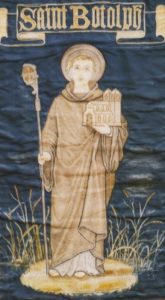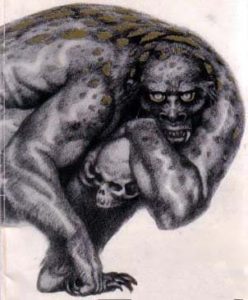
Michigan Catholics have a few options for Friday night dinner during Lent: fish frys, fish sticks, pizza or muskrat.
A long-standing permission allows local Catholics to eat muskrat, a rodent native to the area, “on days of abstinence, including Fridays during Lent.” The custom dates to the region’s missionary history in the 1700s. Missionary priests realized food was scarce in communities close to the Detroit River, so they did not want to deny settlers an available source of protein. 
The Rev. Tim Laboe, dean of studies at Sacred Heart Seminary in Detroit, grew up in an area of Michigan where muskrat dinners have long been a tradition. He remembers eating muskrat with his grandfather. “I don’t know if I enjoy more eating the muskrat or watching people try it for the first time, because it doesn’t look in any way appetizing.”
Laboe, who said he enjoyed muskrat, recalled a quote attributed to the late Bishop Kenneth Povish, the former head of the Lansing Diocese: “Anybody that eats muskrat is doing an act of penance worthy of the greatest of saints.” 

Saint Botulph (also spelled Botolph and Botwulf) was born to a noble Saxon family of Christians in 610 A.D. The boy was sent away to a monastery when Mercian forces under King Penda invaded the region. He became a Benedictine monk at Farmoutiere-en-Brie in France, under the abbess Burgundofara, also known as Saint Fara. He returned to the British Isles in 647 A.D. to establish a Benedictine monastery.
In 654 A.D., Botulph founded the Benedictine monastery of Ikanhoe (Ox Island) with the support of King Anna of East Anglia. The monastery may have even been dedicated to the king. In founding the monastery, Botulph chose a wild, barren fen reputedly haunted by demons. Ikanhoe was surrounded by water and foul-smelling marsh gasses that produced a disturbing nighttime glow. Some early accounts maintain that this was the work of ghosts and devils. Another story claims that a few degenerate descendants of an earlier race may have occupied these Suffolk marshes. These vaguely humanoid creatures are suggestive of the underground beings in Robert E. Howard’s horror story, “Worms of the Earth.” 
It was said that the evil spirits that lived at Ikanhoe were disturbed at Botulph’s arrival. They had dwelt there a long time, they said, and thought that they would do so forever. They had no other place to go. Couldn’t he seek another spot? They felt that the saint was acting unkindly by disturbing them. Botulph didn’t listen to them. The monks built several structures and drained the marshlands. The marsh grass with its “night glow” disappeared. Botulph became revered for his ability to expel bogs of their “devils.” He died on June 17, 680 A.D. after a long illness.
Although many early accounts testify to the existence of Saint Botulph, no one is sure exactly where his monastery was built, since the saint was a traveling missionary in rough bandit and demon-plagued areas. Some think it was at Boston (a shortened form of “Botulph’s Stone”) in Lincolnshire, the home of Saint Botulph’s Church, also known as “The Stump.” The other possibility is Iken, a town in Suffolk. The church there is also dedicated to Saint Botulph. After his death his bones were moved around to protect them from raiders, and as a source of protection for local people against marsh monsters. 
Saint Botulph’s association with hauntings and demons continued after his death. St. Botolph’s Church in Burgh sits on a small mound, suggesting ancient fortifications or burial. The mound had a reputation as the home of a water-loving demon. The nearby town of Grundisburgh may relate to the Anglo-Saxon word, “Grendel,” the fen-dwelling monster of Beowulf. Botulph’s bones were brought to Burgh to exorcise the water demon.
St. Botolph’s Church, Skidbrooke, in the Lincolnshire marshlands, is reputed to be haunted as well. Dating from the early 13th century, it is nicknamed “the demon church” because of all the paranormal activity associated with it. Visitors reported seeing a spectral monk, a headless knight, odd lights, and hearing storm sounds in calm weather. Demons are associated with a specific tomb, which it is said to be an entrance to “dimensional changes.” 
Unfortunately Saint Botulph’s bones were lost during the Dissolution, so he can’t help rid the site of spirits and Satanists. A church grim—a ghost dog guardian–would be helpful, but none are associated with the site.

In a February 6, 2020 speech at the University of San Diego, Bishop Robert W. McElroy of San Diego said “the drive to label a single issue preeminent” in the 2020 election “distorts the call to authentic discipleship in voting rather than advancing it.” Bishop McElroy called both abortion and the environment “core life issues in Catholic teaching.”
“Against the backdrop of these two monumental threats to human life, how can one evaluate the competing claims that either abortion or climate change should be uniquely preeminent in Catholic social teaching regarding the formation of Americans as citizens and believers? Four points should be considered. —There is no mandate in universal Catholic social teaching that gives a categorical priority to either of these issues as uniquely determinative of the common good. —The death toll from abortion is more immediate, but the long-term death toll from unchecked climate change is larger and threatens the very future of humanity. —Both abortion and the environment are core life issues in Catholic teaching. —The designation of either of these issues as the preeminent question in Catholic social teaching at this time in the United States will inevitably be hijacked by partisan forces to propose that Catholics have an overriding duty to vote for candidates that espouse that position.”
Saint Winifred (or Winefride, Welsh: Gwenffrewi) was a Welsh martyr in the 7th century. The spring associated with her martyrdom and restoration is now a shrine. It is called St Winefride’s Well in Holywell, Flintshire, Wales. It is the oldest active pilgrimage site in Britain. The well is open most days of the year and people still go there to bathe and sit on St. Beuno’s stone to ask for favors and blessings. There is a tradition that before he left Holywell, Beuno seated himself on the stone and declared: “Whosoever on that spot should thrice ask for a benefit from God in the name of St. Winifred would obtain the grace he asked if it was for the good of his soul.” 
According to legend, Winifred’s family were descendants of Vortigern, a 5th century warlord. Her mother’s name was Wenlo, and she was a sister of Saint Beuno. Her father, Tyfid ap Eiludd, was the lord of Tegeingl, an area in northeast Wales which later became part of the county of Flintshire.
At the time of her martyrdom, Winifred was a teenage girl preparing to enter religious life. Her uncle, Beuno, was an abbot and her mentor. A local noble by the name of Caradoc approached her to propose marriage. Winifred was not interested in the man’s advances and refused to lay with him. She became frightened and ran to the church where her uncle was saying Mass. The rejected and angry Caradoc followed and caught up with her on the slope of a hill. He drew his sword and cut off her head. The head rolled down the slope and eventually came to rest. As soon as it stopped, a spring of water bubbled up out of the ground.
On hearing of the terrible murder, Beuno left the church and went to the newly formed spring where Winifred’s head lay. He returned the head to the body and covered it with his cloak. After Mass he returned to the body and prayed. Legend says Winifred sat up as if she had been in a deep sleep, with only a thin scar to show where she had been decapitated. 
Seeing Caradoc leaning on his sword with an insolent and defiant air, Beuno called on God to punish him. According to one legend, he died on the spot. Another legend said the ground opened to swallow him. Some historians think he was killed by Winifred’s brother, Owain.
Fearing the encroaching Saxons, Winifred and her companions left Holywell and joined a community of nuns living in Gwytherin near the River Elwy. Winifred eventually became abbess and passed away on November 3 sometime between 650 to 660 A.D.
The oak reliquary of St. Winifred was identified in 1991 from earlier drawings and descriptions. The reliquary probably contained a piece of clothing or article identified with the saint but not her bones. It provides evidence that Winifred was recognized as a saint soon after her death.
The details of St. Winifred’s life are found in two manuscripts. The one in the British Museum is by a monk named Elerius, a contemporary of Winifred. The other manuscript in the Bodleian Library at Oxford is generally believed to have been compiled in 1130 A.D. by Robert, prior of Shrewsbury Abbey. Prior Robert promoted the cult of St. Winifred. In 1138 A.D. her bones were carried with great ceremony from Gwytherin to Shrewsbury. Shrewsbury where they became an extremely popular destination for pilgrims. To further enhance the prestige of the abbey, Abbott Nicholas Stevens built a new shrine for St. Winifred, and had some of his monks steal relics of St. Beuno to add to the abbey church. They abbey was fined, but they were told that they could keep the relics. 
Many royal pilgrims have visited St. Winifred’s Well over the centuries. The earliest recorded visit was by Richard I (King Richard the Lionheart) in 1189. King Henry V made the pilgrimage in 1415 before his victory at Agincourt. In 1416, he went on foot from Shrewsbury Abbey to Holywell as an act of reverence for his victory. In 1461, the future King Edward IV of England went on pilgrimage shortly before the Battle of Towton. According to an account by Welsh poet Tudur Aled, the young king took earth from beside the well and placed it upon his crown. The future Henry VII is thought to have made a secret visit before winning his crown at Bosworth in 1485.
St. Winifred or St. Winifred’s Well have found their way into poems, plays and novels. St. Winifred’s Well is mentioned in the medieval poem, Sir Gawain and the Green Knight. William Rowley’s 17th century comedy, A Shoemaker, A Gentleman dramatizes St. Winifred’s story. Poet Gerard Manley Hopkins memorialized St. Winifred in his unfinished drama, St. Winifred’s Well. 
The most famous references to St. Winifred are in Ellis Peter’s Brother Cadfael mysteries. The story of Winifred’s relics being taken to Shrewsbury Abbey forms the basis of the novel, A Morbid Taste for Bones, the first in her series of Cadfael books. The celebration of her feast day provides the setting for The Rose Rent and The Pilgrim of Hate. The casket containing her relics is stolen from the shrine in The Holy Thief. Brother Cadfael, a Welsh monk at Shrewsbury Abbey is also a former knight and crusader. He has a special affinity with St. Winifred, who he affectionately calls “The Girl.” 

In February 2019 Pope Francis told moral theologians that it was rare, in the sacrament of reconciliation, to hear someone confess to an act of violence against nature and creation. “We do not yet have an awareness of this sin. It is your task to do this.”















